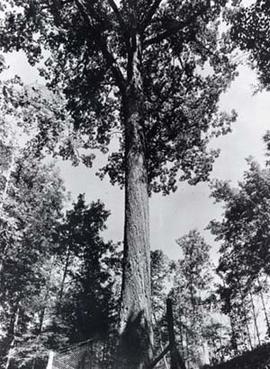
Quercus alba, the white oak, is one of the preeminent hardwoods of eastern and central North America. It is a long-lived oak, native to eastern and central North America and found from Minnesota, Ontario, Quebec, and southern Maine south as far as northern Florida and eastern Texas. Specimens have been documented to be over 450 years old.

Eufaula is the largest city in Barbour County, Alabama, United States. As of the 2010 census the city's population was 13,137.

Bark is the outermost layers of stems and roots of woody plants. Plants with bark include trees, woody vines, and shrubs. Bark refers to all the tissues outside the vascular cambium and is a nontechnical term. It overlays the wood and consists of the inner bark and the outer bark. The inner bark, which in older stems is living tissue, includes the innermost layer of the periderm. The outer bark on older stems includes the dead tissue on the surface of the stems, along with parts of the outermost periderm and all the tissues on the outer side of the periderm. The outer bark on trees which lies external to the living periderm is also called the rhytidome.

The Treaty Oak is a Texas live oak tree in Austin, Texas, United States, and the last surviving member of the Council Oaks, a grove of 14 trees that served as a sacred meeting place for Comanche and Tonkawa tribes prior to European settlement of the area. Foresters estimate the Treaty Oak to be about 500 years old. Before its vandalism in 1989, the tree's branches had a spread of 127 feet (39 m). The tree is located in Treaty Oak Park, on Baylor Street between 5th and 6th Streets, in Austin's West Line Historic District.

Quercus virginiana, also known as the southern live oak, is an evergreen oak tree endemic to the Southeastern United States. Though many other species are loosely called live oak, the southern live oak is particularly iconic of the Old South. Many very large and old specimens of live oak can be found today in the Deep South region of the United States.

The Auburn Tigers are the athletic teams representing Auburn University, a public four-year coeducational university located in Auburn, Alabama, United States. The Auburn Tigers compete in Division I of the National Collegiate Athletic Association (NCAA) as a member of the Southeastern Conference (SEC).

Girdling, also called ring-barking, is the complete removal of the bark from around the entire circumference of either a branch or trunk of a woody plant. Girdling results in the death of the area above the girdle over time. A branch completely girdled will fail and when the main trunk of a tree is girdled, the entire tree will die, if it cannot regrow from above to bridge the wound. Human practices of girdling include forestry, horticulture, and vandalism. Foresters use the practice of girdling to thin forests. Animals such as rodents will girdle trees by feeding on outer bark, often during winter under snow. Girdling can also be caused by herbivorous mammals feeding on plant bark and by birds and insects, both of which can effectively girdle a tree by boring rows of adjacent holes.

The Mingo Oak was a white oak in the U.S. state of West Virginia. First recognized for its age and size in 1931, the Mingo Oak was the oldest and largest living white oak tree in the world until its death in 1938.
Bridgetown is a Canadian community located in north-central Annapolis County, Nova Scotia.

The Tree That Owns Itself is a white oak tree that, according to legend, has legal ownership of itself and of all land within eight feet (2.4 m) of its base. Also known as the Jackson Oak, the tree is at the corner of South Finley and Dearing Streets in Athens, Georgia, US. The original tree, thought to have started life between the mid-16th and late 18th century, fell in 1942, but a new tree was grown from one of its acorns and planted in the same location. The current tree is sometimes referred to as the Son of the Tree That Owns Itself. Both trees have appeared in numerous national publications, and the site is a local landmark.

The Old Avery Oak Tree was a white oak tree that stood in Dedham, Massachusetts until it was knocked down in 1972. It had a circumference of over 20 ft (6 m) and stood on East Street near the Fairbanks House. It was named for Jonathan Avery, the owner of the tree, who had an estate that was bounded roughly by East Street, Mt. Vernon Street, Barrows Street, and Brookdale Avenue. The Avery family was one of the early settlers of Dedham, arriving in 1650.

Carya aquatica, the bitter pecan or water hickory, is a large tree, that can grow over 30 metres (98 ft) tall of the Juglandaceae or walnut family. In the American South it is a dominant plant species found on clay flats and backwater areas near streams and rivers. The species reproduces aggressively both by seed and sprouts from roots and from stumps of cut trees. Water hickory is a major component of wetland forests now in the south eastern US, because of the selective cutting of more desirable tree species for the lumber industry. It is considered important in cleansing drainage waters since the plants slow water flow during flooding, allowing sediments to fall out of the water column. This tree species is tolerant of wet soils but grows best on well draining soils near rivers and other water ways.

Carya myristiciformis, the nutmeg hickory, a tree of the Juglandaceae or walnut family, also called swamp hickory or bitter water hickory, is found as small, possibly relict populations across the Southern United States and in northern Mexico on rich moist soils of higher bottom lands and stream banks. Little is known of the growth rate of nutmeg hickory. Logs and lumber are sold mixed with other hickories. The nuts are an oil-rich food for wildlife.

A stem is one of two main structural axes of a vascular plant, the other being the root. It supports leaves, flowers and fruits, transports water and dissolved substances between the roots and the shoots in the xylem and phloem, stores nutrients, and produces new living tissue. The stem can also be called halm or haulm or culms.

In botany, a tree is a perennial plant with an elongated stem, or trunk, usually supporting branches and leaves. In some usages, the definition of a tree may be narrower, including only woody plants with secondary growth, plants that are usable as lumber or plants above a specified height. In wider definitions, the taller palms, tree ferns, bananas, and bamboos are also trees.

An epicormic shoot is a shoot growing from an epicormic bud, which lies underneath the bark of a trunk, stem, or branch of a plant.

Friendship Oak is a 500-year-old southern live oak located on the Gulf Park campus of the University of Southern Mississippi in Long Beach, Mississippi. The campus was formerly Gulf Park College for Women from 1921 until 1971.

The Suffragette Oak is a Hungarian oak tree in Kelvingrove Park in Glasgow, planted in 1918. It was named Scotland's Tree of the Year in 2015.

Lassington Wood is a nature reserve near Highnam, Gloucestershire. Part of the estate of the Guise family since the 13th century it was donated to Gloucester County Borough Council in 1921. It is now owned by Tewkesbury Borough Council and managed jointly with Highnam Parish Council. The wood was the site of the Lassington Oak, a notable tree until it fell in 1960.

The Newland Oak was a veteran oak tree in Newland, Gloucestershire in England. Originally part of the ancient woodland of the Forest of Dean, it survived clearances that created the settlement of Newland and was afterwards pollarded for timber. Its large size was often remarked upon through the years and it was considered a rival to the Cowthorpe Oak as the largest oak tree in Great Britain. Much of the tree fell during heavy snow in 1955 but a single branch of the tree survived until 1970 when it was killed during an arson attack. A replacement tree grown from one of the Newland Oak's acorns had been planted in 1964.



















